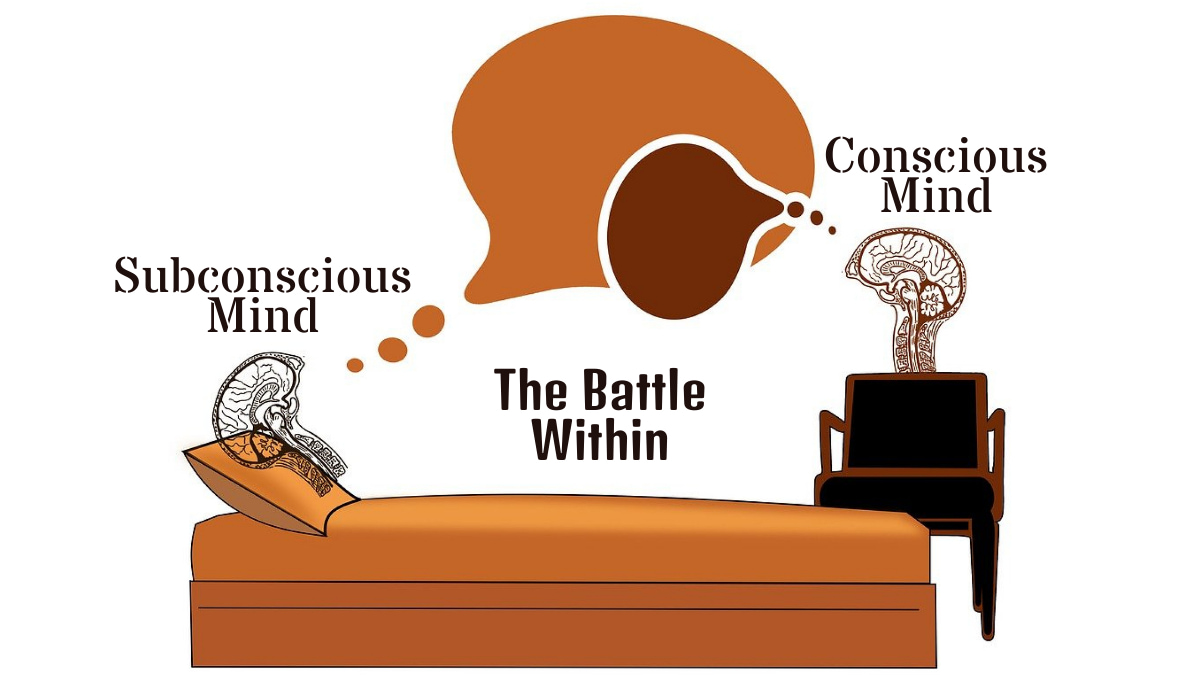Table of Contents
In our minds, there’s a battle going on all the time. It’s not like a fight with fists, but a battle between two powerful forces: the conscious and subconscious mind. These two parts of our mind are like teammates in a game, but sometimes they don’t always agree. Let’s take a closer look at what this battle is all about.
“Between stimulus and response, there is a space. In that space is our power to choose our response. In our response lies our growth and our freedom.” – Viktor E. Frankl
What are the conscious and subconscious minds?
Firstly, let’s understand what each of these parts of our mind does.
The conscious mind is like the captain of a ship. It’s the part of our mind that we’re aware of and that we use for thinking, reasoning, and decision-making. When we’re awake, it’s the part that we actively control. For example, when we’re solving a math problem or deciding what to eat for lunch, it’s our conscious mind that’s doing the work.
On the other hand, the subconscious mind is like the engine room of the ship. It’s working behind the scenes, even when we’re not aware of it. It handles things like our habits, emotions, and automatic bodily functions. Have you ever found yourself humming a tune without realizing it, or suddenly feeling afraid for no apparent reason? That’s your subconscious mind at work.
The Battle Begins: Conscious vs. Subconscious
Now that we know what these two parts of our mind do, let’s talk about how they sometimes clash.
Imagine you have a goal, like wanting to get fit. Your conscious mind might decide that you need to exercise regularly and eat healthily to achieve this goal. So, you start going to the gym and eating salads.
But here’s the thing: your subconscious mind might not be on board with this plan. Maybe it’s used to lounging on the couch and eating chips. So, even though your conscious mind is saying, “Let’s go to the gym,” your subconscious mind might be saying, “No way! I want to stay comfortable.”
This creates a battle within you. Your conscious mind is pushing you to stick to your goal, but your subconscious mind is pulling you back into old habits.
Understanding the Dynamics

So, why does this battle happen? It all comes down to how our minds work.
Our conscious mind is like the tip of the iceberg – it’s the part we can see above the water. But beneath the surface lies the much larger subconscious mind, which holds our beliefs, memories, and emotions.
Many of our behaviours and reactions are shaped by our subconscious mind without us even realizing it. For example, if you were bitten by a dog as a child, you might develop a fear of dogs without consciously knowing why. This fear is stored in your subconscious and can influence how you react to dogs in the future.
Because the subconscious mind is so powerful and influential, it can sometimes override the desires of our conscious mind. This is why we might find ourselves doing things that we know aren’t good for us, like procrastinating or giving in to cravings.
Finding Balance
So, how can we find harmony between our conscious and subconscious minds?
One way is through awareness. By paying attention to our thoughts, feelings, and behaviours, we can start to recognize when our subconscious mind is pulling us in a different direction than our conscious mind.
Another helpful strategy is repetition. The more we repeat a desired behaviour, the more it becomes ingrained in our subconscious mind. So, if you want to develop a new habit, like exercising regularly, keep at it until it becomes automatic.
Additionally, techniques like meditation and visualization can help us access and reprogram our subconscious beliefs. By replacing negative beliefs with positive ones, we can change the way we think and act.
Overcoming Challenges

Even though finding the balance between the conscious and subconscious mind is essential, it’s not always easy. There are challenges along the way that we must overcome.
One common challenge is resistance from the subconscious mind. When we try to make changes in our lives, our subconscious mind might resist because it prefers familiarity and routine. It sees change as a threat to its stability, even if that change is for the better. This resistance can manifest as self-doubt, fear, or procrastination.
Another challenge is the influence of past experiences. Our subconscious mind is like a library filled with memories, both positive and negative. These memories shape our beliefs and behaviours, often without us even realizing it. If we’ve had negative experiences in the past, they can create barriers to success in the present.
However, overcoming these challenges is possible with dedication and persistence. By gently coaxing our subconscious mind to accept change and by reframing negative beliefs with positive ones, we can gradually reprogram our minds for success.
Embracing the Power Within
Despite the battles and challenges, there is immense power within each of us. Our minds are capable of incredible things when we learn to harness their full potential.
By understanding the dynamic between our conscious and subconscious minds, we gain insight into ourselves and our behaviours. We become more conscious of the choices we make and the beliefs that drive us. With this awareness, we can make positive changes that align with our goals and values.
Moreover, by tapping into the power of our subconscious mind, we unlock new possibilities for growth and transformation. Our subconscious mind is like a treasure trove waiting to be explored, filled with untapped potential and hidden talents. When we learn to access this reservoir of creativity and intuition, we open ourselves up to a world of endless possibilities.
Understanding Emotions
Emotions play a significant role in how our minds function. They are signals from our subconscious mind that provide valuable information about our experiences and perceptions.
When we experience strong emotions, such as fear, anger, or joy, it’s often our subconscious mind reacting to a situation based on past experiences or deeply held beliefs. These emotions can influence our thoughts and behaviours, sometimes without us even realizing it.
For example, if we have a fear of public speaking, our subconscious mind might trigger feelings of anxiety whenever we’re faced with the prospect of speaking in front of a crowd. This fear can override our conscious desire to speak confidently, making it difficult to perform at our best.
Managing Emotions
To find the balance between our conscious and subconscious minds, it’s essential to learn how to manage our emotions effectively. This involves acknowledging and understanding our feelings, rather than ignoring or suppressing them.
Mindfulness techniques, such as deep breathing, meditation, and journaling, can help us become more aware of our emotions and their underlying causes. By observing our thoughts and feelings without judgment, we can gain insight into the patterns and triggers that influence our behaviour.
Additionally, practising emotional regulation skills, such as relaxation techniques and positive self-talk, can help us cope with challenging emotions and maintain a sense of balance. By learning to respond to our emotions in healthy and constructive ways, we can prevent them from hijacking our conscious decision-making process.
Conclusion
In short, our feelings are really important in how our minds work. When we understand and control our emotions, it helps our conscious and subconscious minds work together better. This helps us make choices that match what we want in life, leading to more happiness and success. Even though it might seem hard, the battle in our minds is more about working together than fighting. By exploring our subconscious and using its power, we can grow personally and feel more fulfilled. With determination and a willingness to learn about ourselves, we can overcome challenges and achieve our dreams. Just remember, each of us has the power to shape our future – let’s take hold of it and make our lives better.















